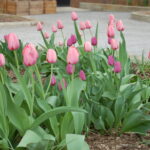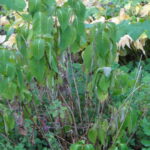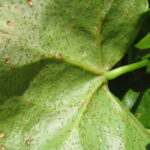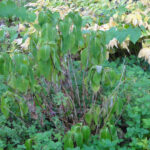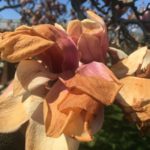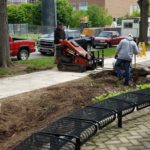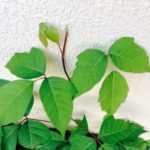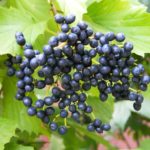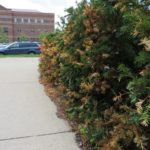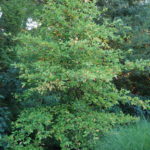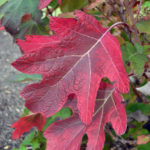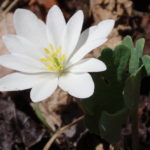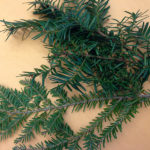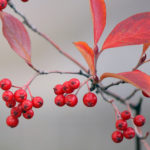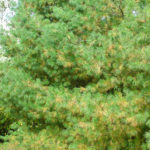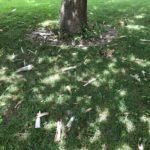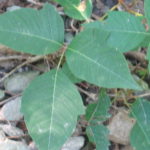If you didn’t get your spring-flowering bulbs planted it may not be too late, but a lot depends on what the weather does. The reason for planting bulbs in the fall is two-fold. Bulbs require a period of chilling to initiate flowers. Most spring-flowering bulbs require 10 to 13 weeks of temperatures below 40º F.[Read More…]
Dry summers are not that unusual in Indiana. Of particular concern this year is that the dry spell is lasting well into autumn, putting plants in poor condition to get through the winter. Figure 1 from the US Drought Monitor shows that much of Indiana remains abnormally dry to under moderate drought. While some[Read More…]
Plants that experience extremes in soil moisture may develop spots on their leaves, called “oedema” (also spelled “edema”). The spots may first appear as a blister or raised spot, particularly on the undersides of leaves, but may occur on the top side as well as on the stems. Eventually, the blister develops a rust-colored, cork-like[Read More…]
Hot, dry summers are not that unusual in the Midwest, but 2020’s hot dry spell started considerably earlier than usual, before summer even officially began! To make it a triple whammy, the hard freeze in early May caused some landscape plants to burn up more stored carbohydrate reserves to produce a second round of foliage.[Read More…]
As so many gardeners are staying at home these days, we’ve had more opportunity to enjoy the spring display. And then, perhaps inevitably, “normal” spring frost and freeze visited – some plants are vulnerable to damage. The amount of damage will depend on how far along they are in their development. Home fruit-growers may have[Read More…]
Day-to-day activities have changed every aspect of businesses throughout the country. The Green Industry is no exception, with changes implemented to maintain safe working environments for employees and their clients while being compliant with the state’s Executive Order. Due to the diversity of services and products that the Green Industry provides, there is no one-size-fits-all[Read More…]
Most gardeners have heard of the wise advice “leaves of three, let it be” referring to the pest plant poison ivy. While not quite as catchy, the saying really should be “leaflets of three, let it be.” Poison ivy leaves are compound rather than simple – a single leaf is divided into three separate portions,[Read More…]
We often receive inquiries from folks wanting to add landscape plants that will attract birds. Most folks primarily think of plants with edible berries. Birds require not only food such as fruits and seeds, but also shelter and water. Planting a variety of plants that offer these resources across the seasons will help attract more[Read More…]
It’s not unusual for Indiana weather to have trouble deciding what season it is. Warm spells during the dormant period often lead to bulbs poking their foliage (and sometimes flower buds) through the soil. While we’re more used to seeing this happen during February warm spells, our frigid temperatures arrived a bit early in the[Read More…]
Deicing salts can save your neck this winter, but they can spell disaster for landscape plants. Whether the salt is sprayed on the plants from passing traffic near the road or is shoveled onto plants near the sidewalk, the salt can cause damage. Salts can adversely affect plants in several ways. Salts deposited on the[Read More…]
If you’re looking to add native shrubs to your home landscape, fall is an excellent time to look for those with good fall color. While many factors affect the display of fall color, there are a number of native shrub species that perform reliably in our area. Here’s a short list to consider including their[Read More…]
Plants differ in their adaptability to different growing conditions. Sunshine is one of the most significant factors. We often think of light as being either sunny or shady, but, in fact, there are many “shades” of light in between. Your garden may experience light shade, such as that filtered through an overhanging tree; dense shade,[Read More…]
Q: I’ve attached pictures of the only tree we have on our property. Because it is our only tree, I am deeply concerned with the possibilities of irreparable damage to it. As you can see, one of the branches broke off during a November windstorm. Unfortunately, that left a bare gap on the trunk. Please[Read More…]
It is easy to confuse Hemlock (Tsuga spp.) and Yew (Taxus spp.) unless you can see the overall plant habit or have them both side by side. Further confusing them is that both species may be pruned into hedges or other shapes that obscure the natural plant habits. Hemlock has short needles, 1/4 – 3/4″[Read More…]
Burning bush is so named for its brilliant red foliage display in autumn. But we sometimes get questions asking why their shrub fails to color up, with leaves that remain green until they drop from the plant. Fall color or lack thereof is affected by a number of factors, including genetics of the plant and[Read More…]
Although most “conifers” are “evergreen”, a few species are “deciduous”. Confused? Perhaps a review of these terms will help. conifer = cone-bearing evergreen = retains at least some green foliage year-round deciduous = all leaves die and are shed annually at same time Evergreens provide green color all year long but that doesn’t mean that[Read More…]
Most landscape professionals and gardeners have heard of the wise advice “leaves of three, let it be” referring to the pest plant poison ivy. While not quite as catchy, the saying really should be “leaflets of three, let it be.” Poison ivy leaves are compound rather than simple – a single leaf is divided into[Read More…]
People often select plants first for their beauty and second for their functionality in the garden. Frequently, we don’t know or don’t consider a plant’s behavior when we’re selecting them. Almost by definition, a species that is an effective ground cover will have a spreading habit. But does that make the species aggressive or invasive?[Read More…]

